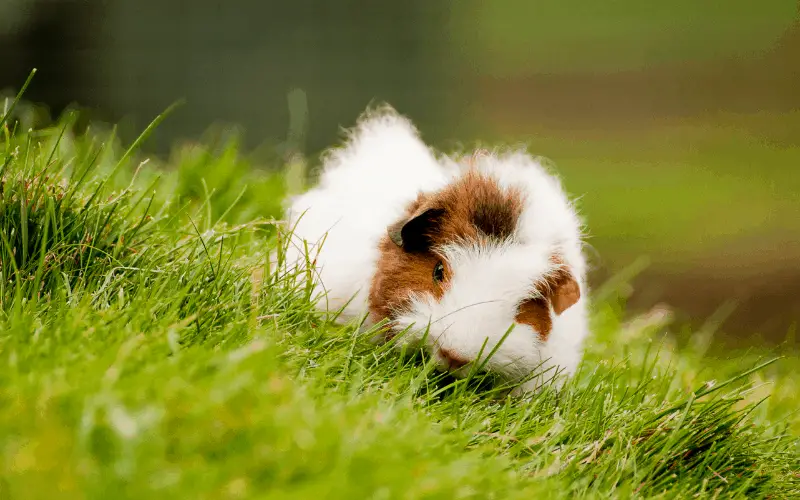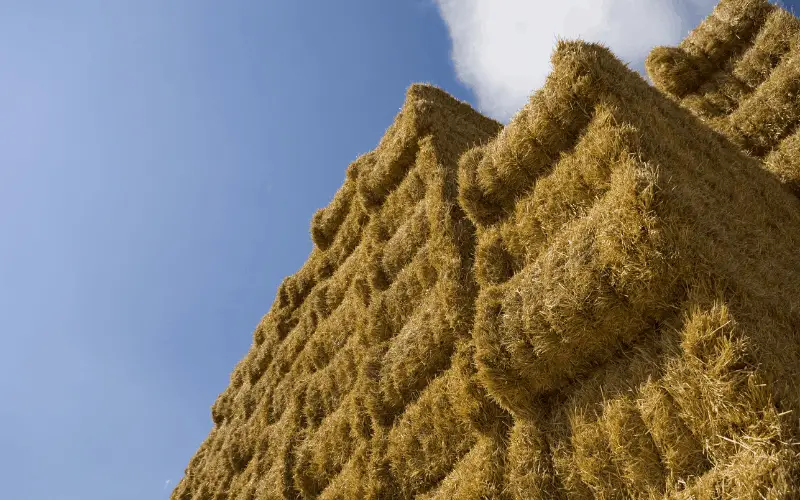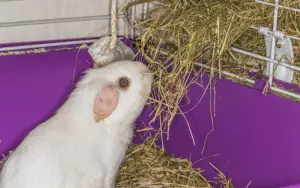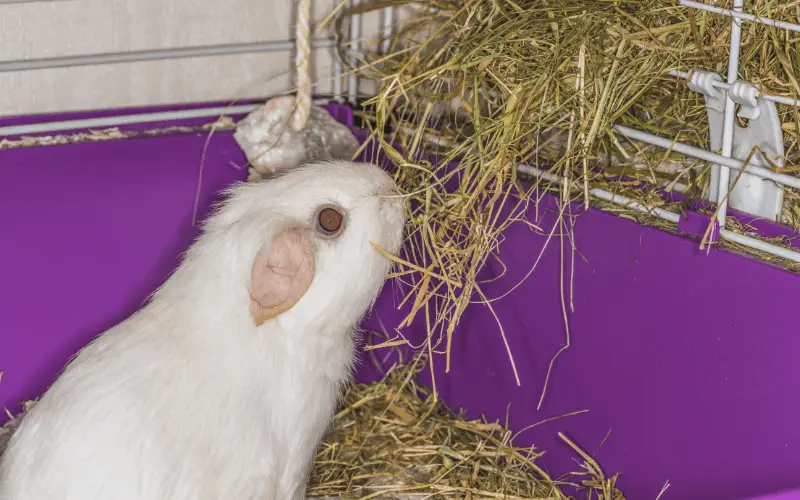Guinea pigs aren’t known to overeat, but you must be aware of the right amount of hay you should provide for your pet. But how much hay should I feed my guinea pig?
This is a question many guinea pig owners ask, especially the new owners. You can feed an adult guinea pig up to 90 to 100 grams of hay daily, but there are other things you need to know.
The good news is that with all the experience we have racked up, we will guide you on the amount of hay guinea pigs can eat daily.
Hay is the nutritional base of a guinea pig’s diet, as pet parents, we should understand the importance of diversity and variety in feeding your little piggies.
How Much Hay Should I Feed My Guinea Pig?
An adult pet guinea pig should be fed 90 to 100 grams of hay daily. Provide fresh hay for your piggy two times per day. We recommend you make two piles around the cage for them to eat and forage.
Guinea pigs younger than six months should be fed with 5 to 6 pounds (2 to 3 kg) of hay monthly. Feed your adult (older than 6 months) guinea pigs 6 to 8 pounds (3 to 4 kg) of hay per month.
You should note that the health condition of your piggy, the quality of hay, and the overall diet will influence the quantity of hay your guinea pig eats.
Your guinea pig’s ideal diet consists of 80% hay. This is so because hay is the most essential part of a guinea’s diet, and there is no alternative to hay.
Suppose you have a piggy that doesn’t like veggies. In that case, you can easily swap the veggies with pellets or even use a different type of vegetable. However, the same can’t be said for hay. There is no hay substitute in the guinea pig’s diet.
Read Also: Why is My Guinea Pig Not Eating Hay?
What Is the Role of Hay in A Guinea Pigs Meal?

Hay is vital in ensuring that the gastrointestinal system is functioning optimally. This is possible because hay is rich in fiber, and fiber is what keeps the gastro intestines continually moving.
Just like a horse, your piggy will not absorb the full nutrients available in their diet in one sitting. So, the guinea must break down a large proportion of the food into colons and cecum.
Then, the guinea pig excretes these colons and cecum as poop and eats it up again at once. Gross? Well to you it might be, but this system is ingenious and efficient and works flawlessly for the guinea pig.
The absence of hay in the guinea pig’s diet will lead to health problems during cecal formation. Also, lack of hay results in low absorption of water, which causes dehydration – a life-threatening condition for piggies.
Furthermore, silica contained in hay helps to prevent dental issues in your guinea pig. Hay naturally wears down the molar teeth; this prevents the teeth from overgrowing. Overgrown molar teeth are fatal in many cases to the guinea pig.
How Much Hay Should You Get?
It is not easy to determine how long a bag of hay will last, so we have taken the liberty to review some of the best and most popular hay for your piggy. Our review covered some of the most economical feeds, and the premium choice feeds.
Kindly remember that the data below has been calculated for a single pig. Therefore, you have to adjust the figures to accommodate the number of guinea pigs you own.
- Oxbow Timothy Hay has a pack size of 9 lbs and will last for 35 to 40 days.
- Standlee Timothy Hay has a pack size of 25 lbs and will last for 90 days and more.
- Small Pet Select Timothy Hay has a pack size of 12 lbs and will last for 45 to 50 days.
- Kaytee Timothy Hay has a pack size of 12 lbs and will last for 45 to 50 days.
Why Isn’t My Guinea Pig Eating Hay?
There are a couple of reasons that prevent your guinea pigs from eating hay. We will discuss some of the most common causes.
1. The Guinea Pigs Do Not Have an Easy Access to the Hay
Many unique styled hay racks limit the access of the guinea pigs to the hay. Although the hay racks might look fantastic, however, its primary purpose is to hold the hay for your piggy to feed on. If the hay rack doesn’t perform this task efficiently, irrespective of its aesthetics, you should discard it.
Hay racks such as the hay ball can trap the head of your guinea pig, further discouraging the piggy from attempting to feed on it again.
2. Poor Quality Hay
Providing low-quality thin vacuum-packed hay to the piggy isn’t ideal. To ensure your pet remains in optimal health, feed the piggy good quality hay regularly.
Here are a few pointers to let you know if the hay is of excellent quality. The hay has a mixed texture, it is not too coarse nor too thin. It is dry, fresh, green, and free from mold. If the hay contains seed heads even better.
3. The Guinea Pig Has Health Issues
Guinea pigs tend to have dental issues that prevent them from feed effectively. Like we said earlier, your guinea pig teeth are always growing. So, there is a need to regular wear down the teeth to keep them in check.
The molar teeth of the piggy can overgrow and form a bridge-like shape over its tongue. This formation will make it almost impossible for your pet to feed, leading to starvation.
Because you cannot tell if the molar has overgrown, we recommend you seek professional veterinary attention if you notice that the piggy isn’t eating correctly.
What Is the Best Way to Store Hay?

The best way to store hay is to keep it in a re-sealable bag free from dampness and rodents in a place shaded from direct sunlight.
Direct sunlight will make the hay lose moisture hence become drier and will a couple of its nutritional values in the process.
The presence of water in the hay bag will cause the hay to form molds. Feeding your guinea pig hay that has molds created on it will cause various diseases and infections to it.
Conclusion
As pet parents, we should focus on providing an ample quantity of high quality, fibrous hay to your piggy every time. This ensures that your adorable little pet has the required amount of fiber to maintain its good health.
Remember to make sure you provide the right amount of hay to the guinea pig as hay constitutes 80% of the guinea pig’s diet.
Good quality hay is what we recommend you use; this will ensure your piggy gets maximum nutritional benefits from feeding on the hay.
Oxbow Animal Health Western Timothy Hay

Oxbow’s all-natural Western Timothy Hay is a nutritious, sweet-smelling grass that will stimulate the appetite of your rabbit, guinea pig, chinchilla, or other small pet.
Product SKU: B000WFRLX2
Product Brand: Oxbow Animal Health Western Timothy Hay
4.7
Pros
- Highly recommended, fresh and green hay
Cons
- Inconsistent that some have poor quality hay
Standlee Premium Western Forage Timothy

Premium Timothy Grass for Small Companion Animals is grown to the proper stage of maturity. The plant is cut, allowing them to sun-cure (dry) to an acceptable moisture level, baled, and hand-selected so only the highest quality forage goes into each bag and box.
Product SKU: B07M9Z9F4W
Product Brand: Standlee Premium Western Forage Timothy
4.5
Pros
- High-quality & lasts a long time
- Richer green, smells fresh and lush
Cons
- Quality of hay vary with dust and little pieces
Small Pet Select 2nd Cutting Perfect Blend Timothy Hay Pet Food

Small Pet Select 2nd Cut Timothy Hay is a perfect balance of stem, seed-head, and leaf to provide the rough fiber needed for normal wear to healthy teeth and yummy features with a fresh smell to keep them coming back for more.
Product SKU: B07CJ2FRNC
Product Brand: Small Pet Select 2nd Cutting Perfect Blend
4.4
Pros
- Fresh, green and fragrantly rich scent
- Reasonable Price
Cons
- Quality of hay vary with dust and small pieces
Kaytee All Natural Timothy Hay

Kaytee feeds more hay to small pets than anyone else. We pride ourselves on providing fresh, tasty, all-natural hay. Grown specifically for small animals, timothy hay is hand selected to ensure long fiber strands and a proper leaf to stem ratio to support your small pet’s digestive health.
Product SKU: B079RR6CC3
Product Brand: Kaytee All Natural Timothy Hay
4.7
Pros
- Good value for the price
- Fresh and green, smells great
Cons
- It contains little dusty and smaller pieces
- Inconsistent that some have poor quality hay
